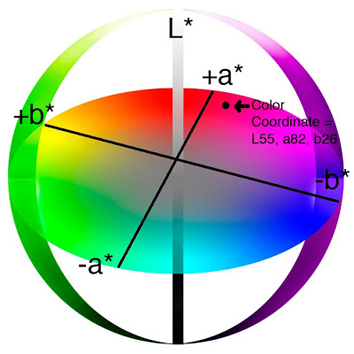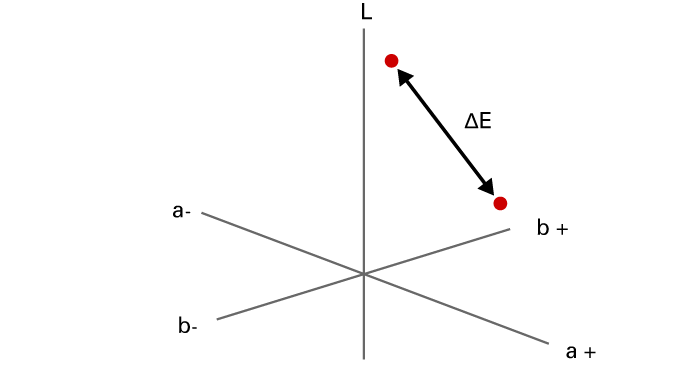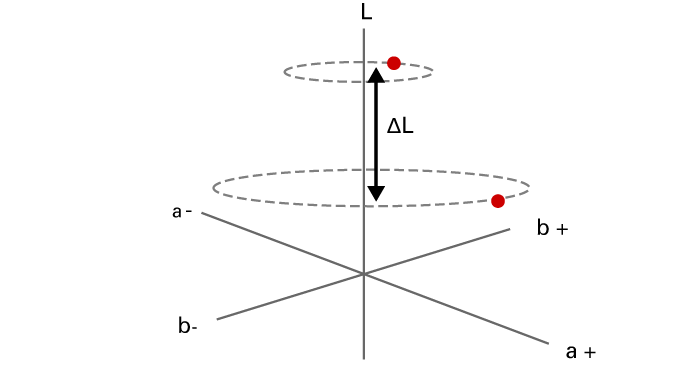

Colour differences are the differences between the requested colours and reproduced colours. These colour differences can be caused by a number of factors, such as printer environment, printer condition, media and output profile.
Colour appearance models are mathematical models that describe the perceptual aspects of human colour vision. The perceptual attributes of colour are lightness, hue and chroma (saturation).
Requested colours, printed colours and measured colours can all be defined with three numerical values that correspond to the perceptual attributes of colour. These three numerical values together form a three dimensional colour space. This representation makes it possible to calculate colour differences by calculating the distance between two colours in a colour space, for example, between a requested colour and printed colour.
The most commonly used colour appearance model offered by the Commission Internationale d'Eclairage (CIE) is CIE L*a*b* (CIELAB).
In this model:
L* represents the lightness (from 0 to 100).
a* represents the green to red axis (from -128 to +127).
b* represents the yellow to blue axis (from -128 to +127).
The a* and b* axes are structured according to an aspect of visual processing called opponency: a colour cannot be both green and red at the same time, neither can it be yellow and blue.
 CIE L*a*b*
CIE L*a*b*In the CIE L*a*b* model, the a* and b* coordinates together are used to derive hue (H) and chroma (C).
The CIELAB colour space is device-independent and based on how humans perceive colour differences. These are the main reasons why the CIELAB colour space is used to indicate colour differences with the help of the colour metrics described below.
Delta E is the most generally used metric to describe colour difference. It describes the straight-line distance between any two points in the CIELAB colour space. As such, it converges the separate attributes of lightness, hue and chroma into one.
Delta E 1976, △E76 is fully described by the sentence above. Delta E 2000, △E00, however, modifies this definition to account for different levels of acuity that human colour vision demonstrates, based on the particular colours being examined.
 Difference between two colours in CIELAB
Difference between two colours in CIELAB The following Delta E00 range illustrates how the values of Delta E can be interpreted for a specific colour evaluation.
Delta E00 smaller than 1 is not visible by humans.
Delta E00 between 1 and 2 is visible through close observation.
Delta E00 between 2 and 10 is visible at a glance.
To provide more detailed colour difference information than the total colour difference Delta E, the hue difference △H (Delta H) is used.
You can imagine Delta H as the colour difference that is left when the lightness and chroma differences are ignored. The hue difference informs you of changes in the relationship between the three colour primaries (cyan, magenta, yellow).
△L (Delta L) is the lightness difference between the two colours. |ΔL| is the absolute value of △L (Delta L) regardless of whether the change from the target colour to the measured colour is negative or positive.
The weighted |ΔL| puts less emphasis on the lightness differences in dark areas because people have greater difficulty perceiving differences in dark colours.

People have increasing difficulty perceiving precise hue differences as colours get close to neutral. △Ch (Delta Ch) can be a more useful metric in the situations when neutral colour balance is in question. Delta Ch converges chroma with hue to provide a combined measure of the distance away from the neutral colour axis.
The weighted Delta Ch puts less emphasis on neutral colour differences above 50%, allowing for greater deviation for dark greys that are harder to distinguish.
There are a number of average Delta colour metrics, for example, [Average ΔE00] or [Average ΔCh composite grays]. These colour metrics indicate the average Delta derived from all calculated individual Delta measurements.
Average metrics provide a better indication of what is generally true regarding overall colour matching performance.
There are a number of maximum Delta metrics, for example, [Maximum ΔE00 CMY solids] or [Maximum ΔH CMYK solids and RGB overprints]. These colour metrics indicate the highest (worst) Delta derived from all calculated individual Delta measurements.
Maximum Delta metrics point to the location and degree of the worst performing colours in the colour space.
95th percentile Delta metrics are used as an alternative to maximum Delta metrics. In 95th percentile Delta metrics, the worst 5% measurements are discarded.
95th percentile Delta metrics are important because maximum Delta metrics are very sensitive. This sensitivity increases the chance of an incorrect validation result: a colour validation fails when the colour quality is in fact good enough, and high colour differences could be caused by measurement errors or print artifacts.
Solids are individual colourants (cyan, magenta, yellow, black) printed at 100%. Overprints are any two colourants printed in combination (magenta with yellow, cyan with yellow or cyan with magenta). There are a number of colour metrics concerned with solids and overprints, such as [Maximum ΔE00 CMYK solids] and [Maximum ΔE76 RGB overprints].
Measuring the colour solids and overprints is important because it provides significant implications for the potentials of colours derived from the solid. If the solid is weak, other mixtures may be influenced.
Composed grey is a grey composed of other colours (cyan, magenta, yellow). These colours taken in correctly balanced amounts neutralise each other and produce neutral (or achromatic) grey.
Measuring the composed grey is important because the human eye is very sensitive to mismatches in neutral colours. A slight colour cast in a neutral grey is seen instantly.